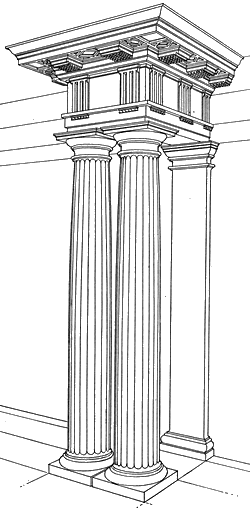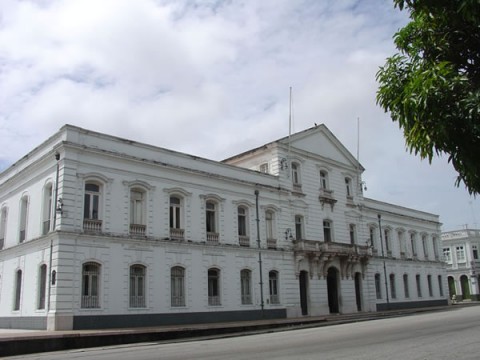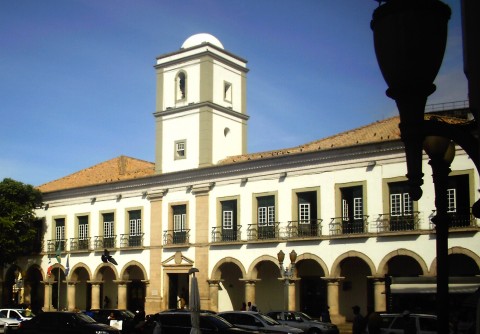Monday, October 3rd, 2011
“Masculine” Civil Architecture in Colonial Brazil
This quarter I am lucky enough to teach a course on Brazilian colonial art. There are hardly any undergraduate courses in the United States that touch on Brazilian art, and I feel really lucky to work at a university that encourages students to expand their interests to include various global topics.
This week I am going to be presenting to my students some of my own research and thoughts on the civil architecture that was constructed in colonial Brazil. Through my own observations, I have noticed that a lot of the civil architecture is constructed with columns and pilasters from the Doric order (an architectural style that developed in ancient Greece).

Example of the Doric order with the plain, unadorned capital, as it appears on both columns and pilasters (rectangular columns embedded into a wall).
I think that this popularity of the Doric order especially interesting, since the Doric order has long been associated as a “masculine architectural style.” In fact, the Roman historian Vitruvius compared the Doric order to the proportions of a man. In his influential writing, On Architecture, Vitruvius explained that the proportions of a man’s foot (in relation to the man’s height) were used to form the Doric order. In contrast, Vitruvius continues to explain that the Ionic order resembles a female, and the Corinthian order can be compared to a slender virgin.1
So, what does this have to do with civil architecture in Brazil? I think that the usage of the Doric order might have had symbolic significance for the European colonists, some of whom probably were familiar with Vitruvius’ text. This “masculine” Doric order would have been in opposition to the Latin American soil, which was considered to have intrinsically female attributes. Annette Kolodny has explored how European colonizers viewed the Americas as having essentially female attributes (“land as woman”), and compared described the American continent to a virgin (“Virgin Beauties”).2 If the American land embodies the qualities that are already interpreted to be part of the Ionic (female) and Corinthian (virgin) orders, then perhaps the Doric order seemed like better point of visual contrast for colonial architecture. But I think that the Doric order is associated with much more than a mere visual contrast to the land. In a way, the rigid, masculine Doric order of the invading colonizers can be interpreted as a masculine European domination over the female Americas.
This theme of architectural domination and conquest can be extended outside gender binaries, too. Previous scholars, such as Gauvin Bailey, have discussed how the classical characteristics of Latin American architecture could have been used to associate the Spanish and Portuguese with the greatness of the Greek and Roman empires. As colonizers and conquerors of the Americas, the Portuguese and Spanish were building their New World empires, following in the footsteps of their classical predecessors.3 Therefore, by association, government buildings could embody authority, conquest, and domination. I feel like all of those characteristics can be seen in the Municipal Building of Salvador (see image above). The classical features such as the Doric capitals, Doric pilasters and arcade all reference the glory of previous empires. I also get a sense of domination from the low-lying, horizontal structure itself: the horizontal emphasis suggests that building wants to cover (or dominate) as much surface area of colonial land as possible.

Antonio Landi, Governor's Palace at Belém do Pará, Brazil, 1771. Landi was an Italian architect who moved to Brazil in the middle of his life. Since Landi worked as a professor of architecture in Bologna, I'm fairly certain that he was familiar with Vitruvius' "masculine" interpretation of the Doric order
I also think that Doric capitals also embody a sense of authority, since it is the most austere and rigid of the classical orders. This rigidity is especially apparent to me in the Governor’s Palace at Belém do Pará (see above), where Doric-like features (suggestive of pilasters) are decorated with quoining. The rigid, rectangular quality of the quoining reinforces the strength and rigidity of the structure (and therefore the governor, by extension). Did you notice that this is another horizontal, low-lying structure that dominates as much surface area as possible?
Any other thoughts on the Doric order and colonial conquest? Civic architecture in Brazil is a very under-explored topic in scholarly research, and I’m always up for generating more conversation!
1 See Vitruvius’ “On Architecture,” (1st century BC). Text from Chapter 1 (which mentions the Greek orders) is found here.
2 For more information on the Americas being interpreted as female (or as a woman), see Annette Kolodny, “The Lay of the Land: Metaphor as Experience and History in American Life and Letters”(Chapel Hill: University of North Carolina Press, 1975), p. 4-7.
3 Gauvin Alexander Bailey, “Art of Colonial Latin America” (London: Phaidon, 2005), 43.
